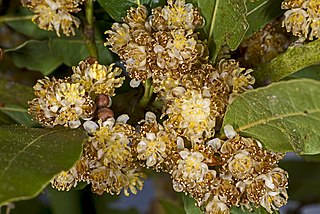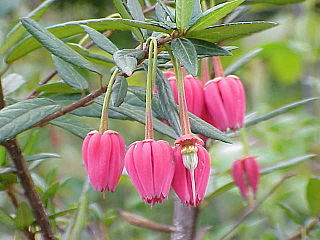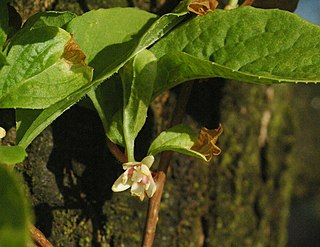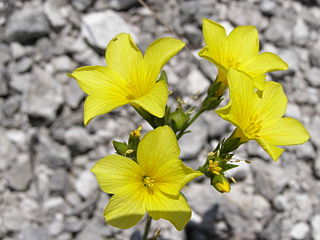
The Laurales are an order of flowering plants. They are magnoliids, related to the Magnoliales.

The Malpighiales comprise one of the largest orders of flowering plants, containing about 36 families and more than 16,000 species, about 7.8% of the eudicots. The order is very diverse, containing plants as different as the willow, violet, poinsettia, manchineel, rafflesia and coca plant, and are hard to recognize except with molecular phylogenetic evidence. It is not part of any of the classification systems based only on plant morphology. Molecular clock calculations estimate the origin of stem group Malpighiales at around 100 million years ago (Mya) and the origin of crown group Malpighiales at about 90 Mya.

The Polygonaceae are a family of flowering plants known informally as the knotweed family or smartweed—buckwheat family in the United States. The name is based on the genus Polygonum, and was first used by Antoine Laurent de Jussieu in 1789 in his book, Genera Plantarum. The name may refer to the many swollen nodes the stems of some species have, being derived from Greek [poly meaning 'many' and gony meaning 'knee' or 'joint']. Alternatively, it may have a different origin, meaning 'many seeds'.

The Araliaceae are a family of flowering plants composed of about 43 genera and around 1500 species consisting of primarily woody plants and some herbaceous plants commonly called the ginseng family. The morphology of Araliaceae varies widely, but it is predominantly distinguishable based on its woody habit, tropical distribution, and the presence of simple umbels.

The Caprifoliaceae or honeysuckle family is a clade of dicotyledonous flowering plants consisting of about 860 species, in 33, to 42 genera, with a nearly cosmopolitan distribution. Centres of diversity are found in eastern North America and eastern Asia, while they are absent in tropical and southern Africa.

Violaceae is a family of flowering plants established in 1802, consisting of about 1000 species in about 25 genera. It takes its name from the genus Viola, the violets and pansies.

Theaceae, the tea family, is a family of flowering plants comprising shrubs and trees, including the economically important tea plant, and the ornamental camellias. It can be described as having from seven to 40 genera, depending on the source and the method of circumscription used. The family Ternstroemiaceae has been included within Theaceae; however, the APG III system of 2009 places it instead in Pentaphylacaceae. Most but not all species are native to China and East Asia.

The Combretaceae, often called the white mangrove family, are a family of flowering plants in the order Myrtales. The family includes about 530 species of trees, shrubs, and lianas in ca 10 genera. The family includes the leadwood tree, Combretum imberbe. Three genera, Conocarpus, Laguncularia, and Lumnitzera, grow in mangrove habitats (mangals). The Combretaceae are widespread in the subtropics and tropics. Some members of this family produce useful construction timber, such as idigbo from Terminalia ivorensis. The commonly cultivated Quisqualis indica is now placed in the genus Combretum. Many plants in the former Quisqualis genus contain the excitotoxin quisqualic acid, a potent AMPA agonist.

Asphodelaceae is a family of flowering plants in the order Asparagales. Such a family has been recognized by most taxonomists, but the circumscription has varied widely. In its current circumscription in the APG IV system, it includes about 40 genera and 900 known species. The type genus is Asphodelus.

Elaeocarpaceae is a family of flowering plants. The family contains approximately 615 species of trees and shrubs in 12 genera. The largest genera are Elaeocarpus, with about 350 species, and Sloanea, with about 120.

Schisandraceae is a family of flowering plants with 3 known genera and a total of 92 known species. Such a family has been recognized by most taxonomists, at least for the past several decades. Before that, the plants concerned were assigned to family Magnoliaceae and Illiciaceae.

Chrysobalanaceae is a family of flowering plants, consisting of trees and shrubs in 27 genera and about 700 species of pantropical distribution with a centre of diversity in the Amazon. Some of the species contain silica in their bodies for rigidity and so the mesophyll often has sclerenchymatous idioblasts. The widespread species Chrysobalanus icaco produces a plum-like fruit and the plant is commonly known as the coco plum.

Erythroxylaceae is a family of flowering trees and shrubs consisting of 4 genera and 271 species. The four genera are AneulophusBenth., ErythroxylumP.Browne, NectaropetalumEngl., and PinacopodiumExell & Mendonça. The best-known species are the coca plants, including the species Erythroxylum coca, the source of the substance coca.

The Marcgraviaceae are a neotropical angiosperm family in the order Ericales. The members of the family are shrubs, woody epiphytes, and lianas, with alternate, pinnately nerved leaves. The flowers are arranged in racemes. The flowers are accompanied by modified, fleshy, saccate bracts which produce nectar. The flowers are pentamerous. The fruits are capsules.

Daphniphyllum is the sole genus in the flowering plant family Daphniphyllaceae and was described as a genus in 1826. The genus includes evergreen shrubs and trees mainly native to east and southeast Asia, but also found in the Indian Subcontinent and New Guinea.

The Cochlospermaceae were a family of two genera and 20-25 species of trees and shrubs, first described by Jules Émile Planchon in 1847. They have been included in the Bixaceae from the APG III system onwards. The older APG II system treated this family as an optional segregate of Bixaceae. They occur widely throughout the tropical regions of the world, but are curiously absent from Malaysia. Most species in this family are mesophytic or xerophytic, growing primarily in drier climates.

Euphronia is a genus of three species of shrubs native to northern South America and is the only genus in the family Euphroniaceae. It was previously classified in the Vochysiaceae family and elsewhere due to its unique floral features, but the APG III system of 2009 recognized Euphroniaceae as distinct and placed Euphronia in it. Based on molecular data from the rbcL gene, it is sister to the Chrysobalanaceae.

The Aptandraceae is a family of flowering plants in the sandalwood order Santalales that is recognized by some sources; others sink the family in Olacaceae. The members of the tropical plant family are parasitic on other plants, usually on the roots, and grow as trees, shrubs or woody lianas.

Sabiceeae is a tribe of flowering plants in the family Rubiaceae and contains about 164 species in 7 genera. Its representatives are found in tropical Africa, Madagascar, Sri Lanka, and from Mexico to tropical America. The genus Sabicea is one of the rare genera in Rubiaceae that occurs both in tropical Africa and tropical America.

Linum ucranicum is a species of flowering plant in the flax genus Linum, family Linaceae, native to Ukraine and parts of European Russia. It is confined to chalk outcrops.




















